
SNIFFING FOR OIL AND EARTHQUAKES
Published in "The Orange Disc", a Gulf Oil Magazine, Fall of 1982
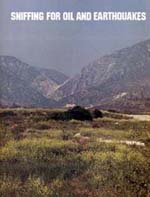 A
severe earthquake almost leveled the Chinese city of Haichang in February
of 1975. Although it was a heavily populated area, there were few casualties.
The earthquake had been predicted and the people had been evacuated several
hours before it occurred.
A
severe earthquake almost leveled the Chinese city of Haichang in February
of 1975. Although it was a heavily populated area, there were few casualties.
The earthquake had been predicted and the people had been evacuated several
hours before it occurred.In an oil field located in Utah’s Overthrust Belt, oil explorationists predicted a westward extension of the field, even though the initial well drilled in the area had been dry. Data suggested that, although that well was a disappointment, the area was potentially productive. Subsequent development drilling proved the prediction to be correct.
What have earthquake prediction in China and oil prospecting in Utah in common? The answer, in a word, is ‘‘geochemistry,’’ the science that deals with the chemical composition of and the chemical changes in the earth’s crust.
Since the 1960s, Russia, China, and Japan -as well as the United States- have been conducting programs in earthquake prediction. The interest these nations have in the subject can be appreciated when it is realized that about 80 percent of the world’s earthquake activity occurs along the land-water boundaries of the Pacific Ocean in what is commonly known as “the ring of fire.”
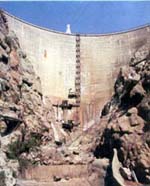 While
traditionally most erthquake data is gathered using seismic methods - measuring
the physical movement of the earth’s crust - in recent years, more
and more attention has been focused on geochemical changes. Researchers
have learned, for example, that there have been significant fluctuations
in the amount of a radioactive gas – radon - emerging from the ground
in fault-zone areas before many earthquakes. Scientists theorize that the
increased strain on rock prior to an earthquake may open microcracks, increasing
the escape of gases trapped in the rock.
While
traditionally most erthquake data is gathered using seismic methods - measuring
the physical movement of the earth’s crust - in recent years, more
and more attention has been focused on geochemical changes. Researchers
have learned, for example, that there have been significant fluctuations
in the amount of a radioactive gas – radon - emerging from the ground
in fault-zone areas before many earthquakes. Scientists theorize that the
increased strain on rock prior to an earthquake may open microcracks, increasing
the escape of gases trapped in the rock.Although the U.S. has not mounted as intense an earthquake prediction program as some of the Asian countries, the Radon-Thoron Monitoring Project being carried out in Southern California along the San Andreas Fault by the California Institute of Technology, has progressed rapidly in the five years it has been in existence. Using high technology, Caltech has a computer system that monitors a series of geochemical variables that it hopes will provide data valuable in earthquake prediction.
Radon is a radioactive gas formed by the decay of uranium, which is found in much of the rock in the earth’s crust. Thoron is an isotope of radon generated by the decay of naturally occurring thorium, another element. Both of these gases (or their radioactive decay products), which are transported by ground water or other gases, can be detected and measured with a Geiger counter.
A network of automated Radon-Thoron monitors for detecting changes in the radon and thoron being emitted from the earth has been developed and is controlled by the Kellogg Laboratory at Caltech. The Caltech monitor has been designed to operate automatically, under the control of a microcomputer, so that data can be collected almost continuously (every eight hours), stored at the site in the computer memory, and transmitted to the central laboratory on call over regular telephone lines.
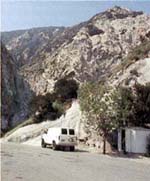 At
the same time geochemistry began to play a greater role in earthquake studies,
the science was becoming more widely used in oil and gas prospecting. Not
that the use of geochemistry is new to the industry. In the early 1930s,
the Germans and, particularly, the Russians, were reporting how subsurface
samples of gas taken from soil overlaying known oil deposits contained greater
quantities of hydrocarbons than similar samples taken at locations far removed
from oil and gas fields.
At
the same time geochemistry began to play a greater role in earthquake studies,
the science was becoming more widely used in oil and gas prospecting. Not
that the use of geochemistry is new to the industry. In the early 1930s,
the Germans and, particularly, the Russians, were reporting how subsurface
samples of gas taken from soil overlaying known oil deposits contained greater
quantities of hydrocarbons than similar samples taken at locations far removed
from oil and gas fields.Gulf first became involved in surface geochemical prospecting in 1932, when A. J. Teplitz and J. K. Rogers of Gulf Research & Development Company attempted to extract ethane from near-surface soils. Great strides have been made in field instrumentation since then, particularly in the past decade. Gulf has been collecting data through a series of surveys, “sniffing” soil gases, since 1972. These surveys have ranged from the Sacramento and San Joaquin Basins of California, through Texas, and northward to the Utah and Wyoming sections of the Western Overthrust Belt, and into the Alberta, Canada, foothills.
The Exploration & Production Division of the Gulf Research Center at Harmarville, Pennsylvania, has published a number of papers on the subject. Findings reported on this extensive field work have indicated that by analyzing near-surface soil gas samples, the oil prospector can determine whether oil, gas, or both have been generated in an area. It is then possible to predict whether oil or gas is more likely to be found by a wildcat well.
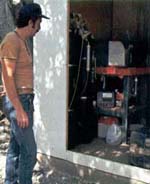 Such
information has considerable commercial value. When drilling a multimillion-dollar
wildcat in a remote corner of the world - or U.S. for that matter- the Company
can reduce the economic risk by knowing beforehand that hydrocarbons are
present in the region.
Such
information has considerable commercial value. When drilling a multimillion-dollar
wildcat in a remote corner of the world - or U.S. for that matter- the Company
can reduce the economic risk by knowing beforehand that hydrocarbons are
present in the region.Dr. V. T. Jones, Director of the Physical Geochemical and Mineral Section of the E&P Division, explained that hydrocarbons are not the only gases that the geochemists have found to be significant. “We can learn a lot from helium, hydrogen, and carbon dioxide, too,” he explained. “Helium is often an indicator of deep faults, fissures that go through the earth’s crust. Helium is generated in the earth by the decay of uranium in the same chain as radon. However, unlike radon, which we know has travelled relatively short distances, the helium - which is not radioactive - may have migrated considerable distances.
“In addition, there is primordial helium trapped within the earth which also escapes along deep fissures, such as the San Andreas Fault in California. Sedimentary gases, on the other hand, are generated from trapped organic material that, under heat and pressure, form hydrocarbon and other gas deposits. Measurement of all these gaseous indicators contributes to our understanding and search for additional hydrocarbons,” he said.
As much of an enthusiast as he is for geochemical prospecting, Dr. Jones is the first to admit that it must be used with caution, and only in conjunction with geological and geophysical tools.
"But if we are to use soil-gas geochemistry effectively,” he continued, “we first must ‘calibrate the tool’. We’re using geochemistry in new and different applications and just don’t have enough background data to work with. Very simply, we need to establish additional baselines. To do this, we needed to find ways of monitoring selected areas on a continuing basis.”
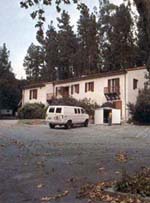 Gulf
researchers have relied largely on vans equipped with gas chromatographs
(instruments that separate and detect gases) and other instruments for field
work. Gulf’s seismic vessel, the R/V Hollis Hedberg, is also equipped
with similar “sniffing” devices to measure gases emanating from
the ocean floor, taking measurements around the clock.
Gulf
researchers have relied largely on vans equipped with gas chromatographs
(instruments that separate and detect gases) and other instruments for field
work. Gulf’s seismic vessel, the R/V Hollis Hedberg, is also equipped
with similar “sniffing” devices to measure gases emanating from
the ocean floor, taking measurements around the clock.In the course of their work along the San Andres Fault in California, Gulf researchers became aware of Caltech’s Radon-Thoron studies aimed at earthquake prediction. Although Caltech’s and Gulf’s objectives were different, they were both attempting to measure emanations of gases from within the earth. An evaluation of the program convinced the Gulf scientists that there was room for collaboration.
“It took a while to convince the Caltech people,” Dr. Jones said, “that we were for real; that what we wanted to do would add to and not interfere with their program.”
The Caltech program was experiencing some financial problems because of cuts in federal aid. When Gulf offered to share the costs of drilling the hole at a new station site being opened by Caltech - provided Gulf could first take some readings at the hole - Caltech agreed.
By the fall of 1980 it was announced in a release from the Caltech News Bureau that “Scientists at the California Institute of Technology and Gulf... have joined in a project to monitor continuously several kinds of gases emanating from the ground near earthquake faults.”
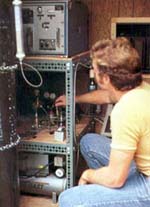 Considerable
progress in the combined effort came about through the work of Dave Masdea,
a technician from Harmarville. Dave was sent to Pasadena to adapt a Gulf
gas chromatograph to the Caltech system. “After several visits by
Dave, who worked with Caltech technician Alan Rice,” Dr. Jones said,
“we had our chromatograph, measuring hydrogen and helium, tied into
the Radon-Thoron monitoring system.” Shortly after it was functioning,
the chromatograph measured a strong hydrogen peak just before an earthquake
hit Westmoreland, California, in April of 1981. Whether a coincidence or
not, this impressed the researchers as to the potential such data might
have in earthquake prediction.
Considerable
progress in the combined effort came about through the work of Dave Masdea,
a technician from Harmarville. Dave was sent to Pasadena to adapt a Gulf
gas chromatograph to the Caltech system. “After several visits by
Dave, who worked with Caltech technician Alan Rice,” Dr. Jones said,
“we had our chromatograph, measuring hydrogen and helium, tied into
the Radon-Thoron monitoring system.” Shortly after it was functioning,
the chromatograph measured a strong hydrogen peak just before an earthquake
hit Westmoreland, California, in April of 1981. Whether a coincidence or
not, this impressed the researchers as to the potential such data might
have in earthquake prediction.“The information from gases such as helium or hydrogen may be complimentary to the radon data,” Dr. Mark H. Shapiro, a visiting associate in physics at Caltech, said. “The behavior of these gases is controlled by different factors. For instance, since radon has a short radioactive half-life, it reflects the stress in a relatively small volume of rock. But since helium is inert and stable, increases may reflect changes in rock stress at greater distances.”
Part of the overall plan includes increasing the number of monitoring stations. Dr. Jonathan D. Melvin, a Caltech Senior Scientist, points out. “Caltech has been operating stations at Fort Tejon, Lake Hughes, Pasadena, Santa Anita, Stone Canyon Reservoir, Big Dalton Canyon north of Glendora, Lytle Creek, Sky Forest in the San Bernardino Mountains, and at Pacoima Dam - the site where Gulf shared the drilling costs. We expect to add stations at Cajalco in Riverside County, near Allendale in the San Jacinto Mountains, and near Anza.”
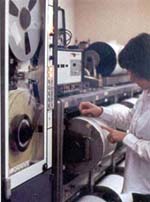 Computerized
gas chromatographs have been installed at Pacoima and at a station on the
grounds of the Caltech Kresge Laboratory in Pasadena. The latter chromatograph
can measure C1-C4 hydrocarbons, in addition to helium and hydrogen. A third
instrument is to be installed at a site yet to be chosen. Gulf researchers
are looking for a station directly on the San Andreas which has a high potential
for seismic activity. Arrowhead Springs near San Bernardino is a likely
candidate. Sampling of gases from this hot spring (80ºC) has showed
that helium and methane are continuously vented at high concentrations.
Computerized
gas chromatographs have been installed at Pacoima and at a station on the
grounds of the Caltech Kresge Laboratory in Pasadena. The latter chromatograph
can measure C1-C4 hydrocarbons, in addition to helium and hydrogen. A third
instrument is to be installed at a site yet to be chosen. Gulf researchers
are looking for a station directly on the San Andreas which has a high potential
for seismic activity. Arrowhead Springs near San Bernardino is a likely
candidate. Sampling of gases from this hot spring (80ºC) has showed
that helium and methane are continuously vented at high concentrations.At several of the established Caltech stations, Gulf has introduced instruments for measuring carbon dioxide. The Caltech scientists are interested because they now believe that CO2 may be the major carrier of radon. The evidence shows that radon peaks are accompanied by similar surges in CO2 at certain sites and during some time intervals.
These are a few examples of the mutual interests Gulf and Caltech are finding in the means of getting to rather different ends. For Caltech, that end remains increasing the accuracy and extending the time in forewarning of the occurrence of earthquakes.
“The shock waves in an earthquake,” Dr. Shapiro said, “are over in a very short period of time. The real devastation can come from fires, flooding, and the disruption of services. If we have enough warning to move fire-fighting equipment to areas where it will not be damaged by the quake; if we can summon emergency crews and have them standing by; if we can turn off valves, shut down equipment, and get traffic off the road, then we can save lives and minimize damage.”
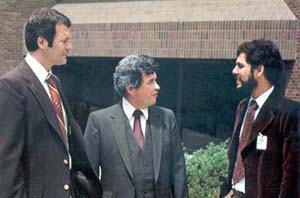 Dr.
Jones said, “We’re pleased to be able to make a contribution
to Caltech’s very worthwhile program; it’s the kind of support
that we feel industry can and should be giving. And there are other advantages
for us at Gulf. Through the Caltech association, we’ve had a technician
get some topnotch training, and all of us in the program are benefitting
from the exposure. Some of the Caltech people have visited us here at Harmarville;
our people have visited Caltech. We have an ongoing dialogue that is very
valuable. The association with Caltech has also helped us recruit some talented
people.”
Dr.
Jones said, “We’re pleased to be able to make a contribution
to Caltech’s very worthwhile program; it’s the kind of support
that we feel industry can and should be giving. And there are other advantages
for us at Gulf. Through the Caltech association, we’ve had a technician
get some topnotch training, and all of us in the program are benefitting
from the exposure. Some of the Caltech people have visited us here at Harmarville;
our people have visited Caltech. We have an ongoing dialogue that is very
valuable. The association with Caltech has also helped us recruit some talented
people.”Gulf scientists hope that the same kinds of information that the Caltech people are seeking, approached and applied somewhat differently, will help in the search for hydrocarbons, a search that is becoming ever more difficult and costly. Dr. Jones said, “As the search gets tougher, we must strive to even the odds with new technology. That’s our primary interest.”